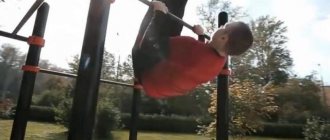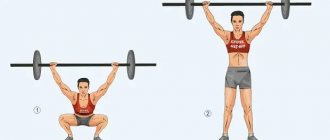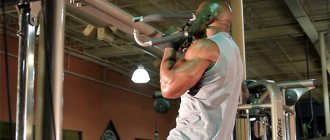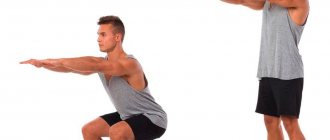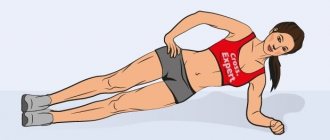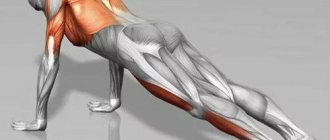- September 15, 2018
- Workouts in the gym
- Olya Bodrova
Having visited the gym for the first time, every young man first begins to master the bench press. The reason for this is the basic nature of this exercise for working the shoulder girdle and pectoral muscles, and, consequently, its inclusion in all subsequent workouts. In addition, all the friends of the training guy ask only one thing - “how much do you bench?” Naturally, you want to increase this indicator as soon as possible, but to increase muscle mass you should choose a different training technique.
Load
To understand how more effective “Guillotine” is than the basic execution, you should familiarize yourself with the results of electromyography performed for the same purpose. The essence of the study is to measure the electrical activity of muscle groups during exercise, the results of which can be used to draw a conclusion about the effectiveness of the work done in the gym.
Thus, the basic bench press turns out to be the most useless, since it loads the chest only in the following ways:
- top – 198;
- middle – 288;
- bottom – 345.
From here it is immediately clear why the majority of athletes who lift weights have a noticeably more developed lower chest. The load of the exercise goes almost entirely to the bottom and involves the top to a minimum.
In the “Guillotine” style, the barbell press demonstrates completely different activity indicators. The top of the chest receives a load of 302 units, the bottom - 502, and the middle - 511. With such research results, we can safely say that this exercise is almost 2 times more effective than the basic one. At the same time, the load on the middle and bottom of the chest is almost the same, which means they will develop together without noticeable differences. Even the upper muscles, which receive noticeably less load in the “Guillotine” exercise, work in it almost the same way as the lower ones in the basic bench press, and there this is the maximum limit! Based on this, there is no point in arguing about the effectiveness of the work done; the main thing is to do it correctly.
Bench press
Bench press
The risk of injury increases if you perform the exercise in a Smith machine . So if you do decide to master the overhead press, be kind enough to take a lighter weight and stay away from machines. Better yet, replace it with something else - for example, swinging dumbbells to the sides . They better load the lateral deltas without the risk of injuring the shoulder girdle.
This exercise is quite popular for working out the lateral deltoids, but it should not be included in the program. The movement is extremely dangerous for the shoulder joint and can lead to serious injury. For example, damage to the rotator cuff tendons.
History of appearance
If one of the young people training in the gym has just learned about this exercise, then this is only his miscalculation. The Guillotine bench press style appeared back in the distant “golden era” of bodybuilding. One of the most famous trainers at that time was Vince Gironda, who invented this exercise through lengthy experiments on his own body.
Vince wanted to learn absolutely every technique to perform the exercise in order to maximize the effectiveness of his training. Thanks to his fanaticism, today all bodybuilders know the possibility of maximizing the development of the pectoral muscles. To do this, the bar should be lowered closer to the neck, making the work more difficult for the chest. It was its approach to the throat that became the reason for such a creepy name, because if the barbell is poorly fixed and dropped directly on your neck, the result will be disastrous.
Headstand push-ups
Exercises using your own body weight are one of the trends in recent years. Push-ups, training on horizontal bars - all these things have become the basis of strength training and CrossFit training for many.
Vertical push-ups with a headstand in the lower position
One popular type of push-up is upside down. In themselves, they are already traumatic, but some manage to make them even more risky by standing on their heads in the bottom position . This technique is often promoted by CrossFit trainers, and they are sorely mistaken. The vertebrae of the cervical spine are the thinnest and most fragile because they must maintain mobility to rotate the neck. Unfortunately, they simply cannot cope with body weight.
The solution is to perform push-ups upside down with proper technique, without standing on your head in any way. And for inexperienced athletes it is better to postpone them altogether until better times.
Basic technique
To master the Guillotine exercise, you must first understand the basic technique. The main problem for most beginners is that the bench press is performed incorrectly or incorrectly. In the latter case, this indicates the correct technique, but not for the goals that the athlete faces. It often happens that a novice bodybuilder does everything as expected, but the muscles do not grow. The problem here is that different correct techniques are aimed at radically different results. You can press a barbell this way to increase muscle mass or increase endurance, that is, lift more weight.
Some training basics
1.
There are such concepts as naturalness of movement and risk of injury. The guillotine is not a natural movement at all and has a very high risk of injury. The shoulder joint pays for its mobility with instability, and joint structures can be injured when movement is not natural. The humerus and scapula joint have a complex anatomical structure, and when the elbow is raised above the level of the sternum with weights in this exercise, various structures between the ligaments and bones are pinched - tendons, muscles, bursa. Gradually, the structures fray and inflammation occurs.
Restoring such structures (from microdamage) takes more than a month, and training with the guillotine can happen almost every week. It can be assumed that the rotator cuff is injured - a group of 4 muscles, the tendon of the long head of the biceps, up to inflammation of the bursa, ligaments and bones when training through pain. Once one or more of the rotator cuff muscles become inflamed, you will be unable to perform intensely in almost any exercise that involves movement of the humerus.
2.
The goal of fitness classes is to be healthy and fit. As we know, gaining muscle mass without preparing for the upcoming bodybuilding competition is a fitness activity, not a sport. Most people in fitness clubs do fitness.
3.
Training to gain muscle mass is very long, it is impossible to build up in 3-6 months. We need to look at what will happen in the long term.
Considering these three points, we can come to the conclusion that you are unlikely to be able to swing using this exercise for the chest, because... you will develop acute or chronic injuries and stop exercising intensely before reaching the finish line.
4.
The principle of load progression and general adaptation syndrome. The main condition for growth is a smooth progression in loads and stress on the neuromuscular system, which should be slightly higher than usual. By applying these training truths, you will grow from any exercise, even without a guillotine, if you do it right! If there is no growth, then the reason is not the lack of a guillotine or other exercises, the matter is completely different.
Lifting weights
To increase your performance in lifting weights, the technique should be selected with maximum muscle unloading. The easier it is for them to work, the more the athlete will be able to take. By the way, this is the technique that is most often found in gyms. They call it the elevator operator.
The main task is to transfer as much load as possible from the chest to other muscles. To do this, you need to arch your back into a “bridge,” thereby reducing the amplitude of the barbell stroke. Lowering the projectile to the bottom of the chest also gives a similar result. During this exercise, your legs rest on the floor, which allows you to control your back.
Basic errors during execution
Too much weight
And again everything comes down to this problem. As already mentioned in this article. The Svend press is not a mass-gaining exercise. Therefore, there is no point in taking heavy weights. Yes, and doing this will be quite problematic. After all, the technique of execution requires its precise execution. And if you cannot hold the discs, then your legs will come under attack. Which they might fall on. Do you need such consequences? I think no. That's why we work on technology. Even with a weight of 2.5 kilograms.
Relaxation of the chest
If you feel that you no longer have the strength to squeeze the discs with your hands. Then just stop doing the exercise. And after you rest, reduce the weight and continue doing it for the specified number of times. If you don't take this break. Then there will be a risk of dropping the discs. This means that the legs will be hit again. Over time, your pecs will get stronger, and you will be able to safely do the set number of reps per set.
Converting the exercise into an arm extension
This is the most common mistake. Instead of pulling their shoulders back, people simply bend their arms. Thus, the movement is performed using the biceps, not the pectorals. But our task is not to develop the biceps brachii muscle. Therefore, we focus on breast work.
Something in between
Barbell chest exercises can immediately train your endurance and help you gain mass. To do this, the technique described above is slightly modernized, making the arch in the back less pronounced. At the same time, the bar also lowers to the bottom of the chest, but due to the smaller “bridge” the load on the chest increases.
Professional bodybuilders do not recognize this technique at all, and it can only be found in amateur gyms. The fact is that the exercise does not have a clear focus, which means that the result will be poor in terms of gaining mass and increasing the weight lifted.
Monkey grip
In another way it is called the suicidal grip, we think you can guess why.
Typically, when you hold the bar, your four fingers are on one side of it and your thumb is on the other. This grip is called closed . It holds the weight securely and prevents it from sliding down.
Monkey grip: thumb on the same side as the rest
In a monkey grip, all five fingers are placed on one side and the weight rests on the wrist. This type of grip is easier for some athletes, and powerlifters sometimes use it to lift more weight. Alas, not without health risks.
Unfortunately, the sport knows a large number of cases when, despite the professionalism of the bencher, the bar breaks off and falls along with the weight onto the chest, sending the athlete to intensive care. It is for this reason that this type of grip is prohibited according to the rules of the IPF (International Powerlifting Federation), and we do not recommend using it in the gym, even at gunpoint.
Pumping up muscles
Now it’s time to talk in detail about the “Guillotine” exercise. It is this pressing technique that makes the work of the chest muscles as difficult as possible and allows you to maximize their size. To perform a bodybuilding bench press, arching in the back should be completely eliminated so that all the load goes to the chest. To do this, the feet should be placed on a bench, closer to the buttocks, or even raised up, keeping the legs bent at the knees.
It is necessary to lower the projectile closer to the neck, which increases the amplitude of the barbell stroke and increases muscle stretching.
Interesting Facts
Here are a number of outstanding records in the history of the bench press.
- The world record for bench press in multi-equipment belongs to the American Ryan Kennealy and is 485.4 kg in the 155+ weight category.
- The Russian record holder for bench press in multi-equipment is Tsukanov Maxim, he was able to bench press 267.5 kg in the heavy weight category 140+.
- Without equipment, the maximum pressed weight is 319.8 kg, and this record belongs to James Henderson. Weight category is also 155+.
- If we talk about girls, the current world record for bench press in multi-equipment is 188.2 kg. It was established in 2016 by Lexi Harris in the heavy weight category of 100+ kg.
- Without equipment, Abigail Wade was able to squeeze the most; her record is 150 kg in the 100+ weight category.
The video presents the standards and execution schemes, and will also tell you how much athletes work out to achieve a rank.
Performance nuances
To increase the load on the muscles to the maximum, you should work with the projectile only within the amplitude. Simply put, you cannot fully extend your elbows while lifting the barbell. For safety, only a wide grip should be used in this exercise. This will take the pressure off your triceps and help you maintain balance. Also, a wide grip will allow you to stretch your pectoral muscles more, and therefore accelerate their growth.
Reviews of the Guillotine exercise from professionals also indicate the use of only a closed grip to protect yourself when lifting medium weights. The thumb should form a ring around the bar along with the rest and lie between the ring and index fingers.
It is the increased load on the muscles being worked in bodybuilding that accelerates the growth of muscle mass. If you simplify the work of your body, the result will be completely different. Endurance, strength and speed of work will increase, but the mass will remain the same.
Get pumped up at any cost, guillotine exercise
Hello everyone, SPORT SCIENCE Questions and Answers here.
Viktor Nadtochiy asks: “Make an episode about the theory of destruction and accumulation, and about this fucking GUILLOTINE!!!?”
Many minds have been wrestling with the eternal question of which came first, the chicken or the egg, for hundreds, if not thousands, of years. The same applies to the sore point - what exactly makes muscles grow.
To put it roughly, training causes a certain stress, which shifts the scales, thereby disturbing the balance; our body tries to return to this same balance and triggers adaptation mechanisms.
The whole question is what type of training will shift us more out of balance, thereby causing the greatest response, and in general is there any point in shifting our system too much, because on the one hand, the more we move it, the stronger the changes should be, but on the other hand On the other hand, this process will cost more in terms of energy and time. This is the stumbling block for many sports minds.
There are so-called theories of accumulation and destruction.
No pain - no gain, tear your ass, and everything like that - this is the theory of destruction. Its main postulate is that the more you invest in training, the stronger you will grow in the future, since constant and strong unsettling will not be beneficial for our body and it will be easier for it to once and for all restructure itself in accordance with training stress.
Attention!
The accumulation theory believes that it is not a matter of destruction as such, but of muscle activity itself. That is, muscle activity itself activates the processes of protein synthesis, glycogen accumulation and, ultimately, muscle growth.
In accordance with this theory, it is believed that the less you injure muscle fibers, with their maximum physical activity, the better the final result will be, because the body will not have to spend additional resources on eliminating the injuries received, and it will spend all its strength on strengthening existing structures.
Enough with the clever words. Can you simply tell us how a straight man can get pumped up? To tear or not to tear your ass?
To put it really simply, you need to tear it, but not to extreme measures. If you really give 100% in every workout and continue to linearly increase the load, then you will not only hit a plateau, but also get injured. Personally tested on myself and many other athletes.
This way you will be able to increase your physical capabilities and will increase your muscle mass.
We had an episode on how a natural athlete can get pumped up. Traditionally, you can find a link to it in the description of the video.
Now we can answer the second question very briefly. The guillotine exercise changes the usual technique of bench press lying on a horizontal bench in such a way that it completely eliminates arching in the lower back and sets a point at which we lower the barbell not on the lower chest, but on the throat.
Important!
Thus, a very strong stimulation of all parts of the pectoral muscles really occurs. However, we do not recommend performing this exercise, since despite the extremely productive stimulation, this movement, which disrupts the natural trajectory of movement for our body, puts a powerful negative load on the shoulder girdle. Therefore, it is extremely easy to get injured in it.
It is this factor that completely covers up all the undeniable advantages of this exercise.
Well, don’t be rednecks, like this video, ask a question that interests you, share the episode with your friends and hit that bell that everyone is tired of. Well, what did you want, for whom is it easy now)
Gironde recommendations
It is already clear which muscles the “Guillotine” exercise affects; the main nuances of its implementation are also listed, but there are several more tips from the very discoverer of this type of barbell press.
The founder of the “Guillotine” style emphasized the need to increase the amplitude of the barbell stroke to the maximum, which means lowering it strictly on the throat, as close to the head as possible. Ideally, the legs should be held suspended with knees bent and ankles crossed. This will make it possible to completely eliminate arching in the back, even if the muscles contract uncontrollably. In addition, a wide grip will further increase the amplitude, stretch the chest muscles more strongly and minimize the work of the triceps.
Adviсe
- Don't pause at the bottom. As soon as the barbell touches your chest, do not relax your muscles and, using the energy available in them, press the barbell up. By stopping, you reflexively worsen muscle contraction and, in order to squeeze the barbell, you will need to “gather all your strength into a fist” again, spending additional energy on this. In addition, with each new repetition it will become more and more difficult to do this. Ultimately, you may not complete the intended number of repetitions.
- Stopping your breathing during the bench press is extremely important for keeping your torso in a safe, stable position and helps you develop a significantly stronger load. Do not forget, the more stable the position of the torso, the more intense the work of the muscles and the less pressure on the joints.
- Don't stop breathing for too long. When performing the exercise at an average pace, holding your breath should last about 2-3 seconds.
- After going through the most difficult part of the movement while lifting the bar, finish the repetition with a deep exhalation. If you feel a lack of strength, ask your partner for help. Never stop halfway! The barbell must be in motion all the time.
- The heavier the barbell, the more tense the muscles are and the more you have to exhale as you go through the toughest part of the barbell lift.
- When pressing the barbell, press your feet into the floor with all your might, hold the bar as tightly as possible, and do not lift your shoulders and hips off the bench. This will stabilize the torso and allow you to achieve maximum contraction of the chest muscles.
- At the bottom, do not squeeze the barbell with your chest, bending your whole body upward. This can cause injury!
Reviews
According to reviews from bodybuilders who have tried this exercise on themselves, the main difficulty is maintaining balance. To perform a clean bench press, you should start with light weights and place your feet on the bench.
In the future, you can use a footrest and only then begin to work with the recommended technique. Athletes are also advised not to experiment with grips, but to strictly follow the technical recommendations. The fact is that open and narrow grips cannot provide the necessary balance and safety. When lifting a medium weight, an insecurely grasped barbell can fall straight onto your neck.
To avoid sad consequences, even light weights should be lifted only with a partner and until the technique is clean, do not increase the load.
How to Make Progress in the Bench Press
- Alternate the load and intensity of your training. Experienced athletes devote no more than 2 workouts in a row to their chest. Ideally - once every 5 days;
- Learn to lower the projectile correctly. A competent negative phase is an art.
- Train regularly, constantly work on your technique. Skipping workouts will set you back.
- Get ready for training. Concentrate powerfully on the mechanics of how you will perform the exercise.


